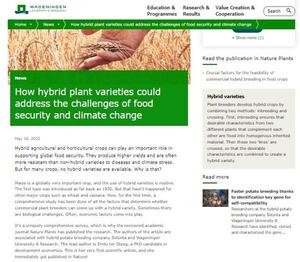- ENDURE...
- Che cos'è ENDURE?
- A proposito della protezione delle colture
- Le pubblicazioni di ENDURE
- All the news


Factors limiting hybrid plant varieties
Experts from Wageningen University & Research (WUR) and Solynta, a Dutch hybrid potato breeding company, have completed a major survey on all the factors that determine whether commercial plant breeders can produce hybrid varieties of food crops.
Hybrid crops have particular qualities, such as higher yields and greater resistance than non-hybrid varieties to diseases and climate stress. However, though hybrid varieties have a long history, beginning with maize in the 1930s, in many crops no hybrid varieties are available.
To address this, Dutch researchers have completed a comprehensive study of all the factors that determine whether it is feasible for commercial breeders to produce hybrid varieties. These factors are often economic, explains the WUR website.
Lead author of the study, Emily ter Steeg, explains on the website what a hybrid variety is and how it is created. “It’s a descendant of two parental plants who complement each other perfectly. The hybrid then combines the best qualities of the parents,” she tells the website.
As WUR explains, to generate suitable parents, you need to ensure that they are genetically as uniform as possible (homozygous). You can do this by crossing the parents with themselves - a process called ‘selfing’ or ‘inbreeding’. “Developing strong parent lines takes time and costs money. So the plant breeder needs to be confident of getting a return on this investment,” Emily tells the website.
The WUR website identifies the obstacles that have to be overcome. It says: “First of all, it needs to be biologically possible to produce those homozygous parental lines. A self-pollinating plant is ideal: while it is much harder for plants that always cross-pollinate with another plant. Moreover, some crops also have multiple sets of chromosomes, which makes it even harder, or close to impossible, to produce inbred parent lines.” It notes, however, that progress is being made even in very difficult crops, such as potato.
Researchers examined the economic drivers for developing a hybrid variety. On one side of the coin is the cost of the development process and on the other the expected financial return. “Large markets or markets with high value added are more profitable for plant breeders. That’s why you see hybrid varieties of major global crops and important vegetables but less so for small local crops,” Emily tells the website.
“Also, the market price of the harvested products determines how much a grower is willing to invest in seeds. Therefore, market prices for growers influence seed prices and revenues of plant breeders.”
The researchers note the lack of progress in breeding some staple crops that are important for food security around the world, including cassava, sugarcane and sweet potato, in addition to traditional leafy vegetables and fruit. Emily tells the website: “If we want to improve and ensure access to nutritious food in poorer countries, it’s important to make progress in commercially less attractive crops too.”
The authors of the study, which appears in Nature Plants, recommend public-private partnerships if plant breeders cannot see an immediate business case. This approach has been used in the Netherlands where, for example, genotypes (known as semi-finished products) of pepper and tomato have been supplied to breeding companies for the development of new disease-resistant varieties.
For more information:
Last update: 24/05/2023 - ENDURE © 2009 - Contact ENDURE - Disclaimer